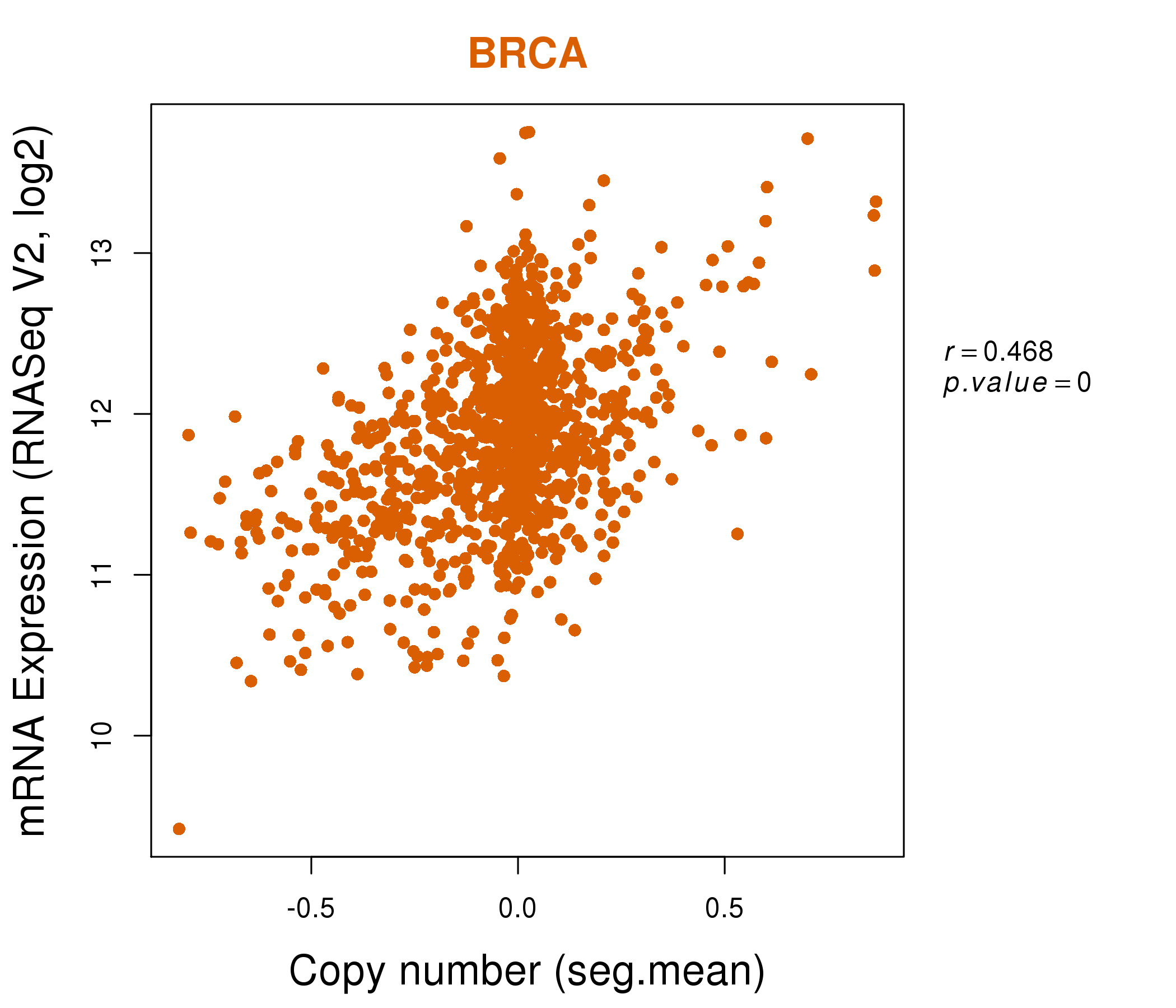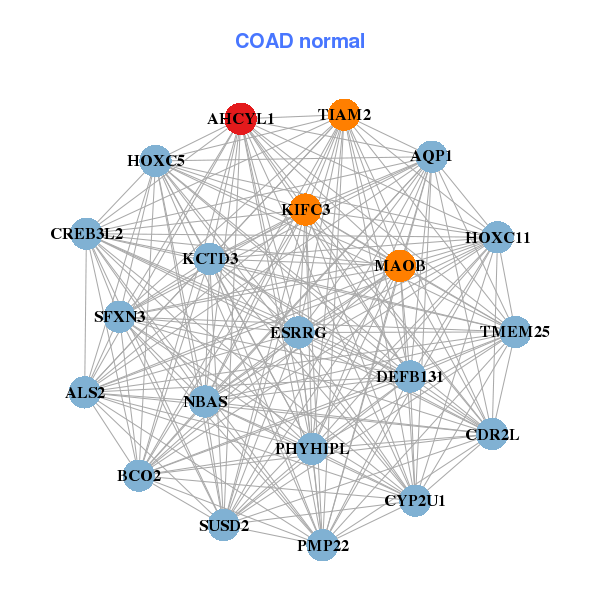|
||||||||||||||||||||||||||||||||||||||||||||||||||||||||||||||||||||||||||||||||||||||||||||||||||||||||||||||||||||||||||||||||||||||||||||||||||||||||||||||||||||||||||||||||||||||||||||||||||||||||||||||||||||||||||||||||||||||||||||||||||||||||||||||||||||||||||||||||||||||||||||||||||||||||||||||||||||||||||
| |
| Phenotypic Information (metabolism pathway, cancer, disease, phenome) |
| |
| |
| Gene-Gene Network Information: Co-Expression Network, Interacting Genes & KEGG |
| |
|
| Gene Summary for AHCYL1 |
| Basic gene info. | Gene symbol | AHCYL1 |
| Gene name | adenosylhomocysteinase-like 1 | |
| Synonyms | DCAL|IRBIT|PPP1R78|PRO0233|XPVKONA | |
| Cytomap | UCSC genome browser: 1p13.2 | |
| Genomic location | chr1 :110527386-110566364 | |
| Type of gene | protein-coding | |
| RefGenes | NM_001242673.1, NM_001242674.1,NM_001242675.1,NM_001242676.1,NM_006621.5, | |
| Ensembl id | ENSG00000168710 | |
| Description | DC-expressed AHCY-like moleculeS-adenosyl homocysteine hydrolase homologS-adenosyl-L-homocysteine hydrolase 2S-adenosylhomocysteine hydrolase-like protein 1adoHcyase 2dendritic cell expressed AHCY-like proteininositol 1,4,5-trisphosphate receptor-bi | |
| Modification date | 20141207 | |
| dbXrefs | MIM : 607826 | |
| HGNC : HGNC | ||
| Ensembl : ENSG00000168710 | ||
| HPRD : 07613 | ||
| Vega : OTTHUMG00000011652 | ||
| Protein | UniProt: go to UniProt's Cross Reference DB Table | |
| Expression | CleanEX: HS_AHCYL1 | |
| BioGPS: 10768 | ||
| Gene Expression Atlas: ENSG00000168710 | ||
| The Human Protein Atlas: ENSG00000168710 | ||
| Pathway | NCI Pathway Interaction Database: AHCYL1 | |
| KEGG: AHCYL1 | ||
| REACTOME: AHCYL1 | ||
| ConsensusPathDB | ||
| Pathway Commons: AHCYL1 | ||
| Metabolism | MetaCyc: AHCYL1 | |
| HUMANCyc: AHCYL1 | ||
| Regulation | Ensembl's Regulation: ENSG00000168710 | |
| miRBase: chr1 :110,527,386-110,566,364 | ||
| TargetScan: NM_001242673 | ||
| cisRED: ENSG00000168710 | ||
| Context | iHOP: AHCYL1 | |
| cancer metabolism search in PubMed: AHCYL1 | ||
| UCL Cancer Institute: AHCYL1 | ||
| Assigned class in ccmGDB | C | |
| Top |
| Phenotypic Information for AHCYL1(metabolism pathway, cancer, disease, phenome) |
| Cancer | CGAP: AHCYL1 |
| Familial Cancer Database: AHCYL1 | |
| * This gene is included in those cancer gene databases. |
|
|
|
|
|
|
| ||||||||||||||||||||||||||||||||||||||||||||||||||||||||||||||||||||||||||||||||||||||||||||||||||||||||||||||||||||||||||||||||||||||||||||||||||||||||||||||||||||||||||||||||||||||||||||||||||||||||||||||||||||||||||||||||||||||||||||||||||||||||||||||||||||||||||||||||||||||||||||||||||||||||||||||||||||
Oncogene 1 | Significant driver gene in | |||||||||||||||||||||||||||||||||||||||||||||||||||||||||||||||||||||||||||||||||||||||||||||||||||||||||||||||||||||||||||||||||||||||||||||||||||||||||||||||||||||||||||||||||||||||||||||||||||||||||||||||||||||||||||||||||||||||||||||||||||||||||||||||||||||||||||||||||||||||||||||||||||||||||||||||||||||||||
| cf) number; DB name 1 Oncogene; http://nar.oxfordjournals.org/content/35/suppl_1/D721.long, 2 Tumor Suppressor gene; https://bioinfo.uth.edu/TSGene/, 3 Cancer Gene Census; http://www.nature.com/nrc/journal/v4/n3/abs/nrc1299.html, 4 CancerGenes; http://nar.oxfordjournals.org/content/35/suppl_1/D721.long, 5 Network of Cancer Gene; http://ncg.kcl.ac.uk/index.php, 1Therapeutic Vulnerabilities in Cancer; http://cbio.mskcc.org/cancergenomics/statius/ |
| KEGG_CYSTEINE_AND_METHIONINE_METABOLISM KEGG_SELENOAMINO_ACID_METABOLISM | |
| OMIM | |
| Orphanet | |
| Disease | KEGG Disease: AHCYL1 |
| MedGen: AHCYL1 (Human Medical Genetics with Condition) | |
| ClinVar: AHCYL1 | |
| Phenotype | MGI: AHCYL1 (International Mouse Phenotyping Consortium) |
| PhenomicDB: AHCYL1 | |
| Mutations for AHCYL1 |
| * Under tables are showing count per each tissue to give us broad intuition about tissue specific mutation patterns.You can go to the detailed page for each mutation database's web site. |
| - Statistics for Tissue and Mutation type | Top |
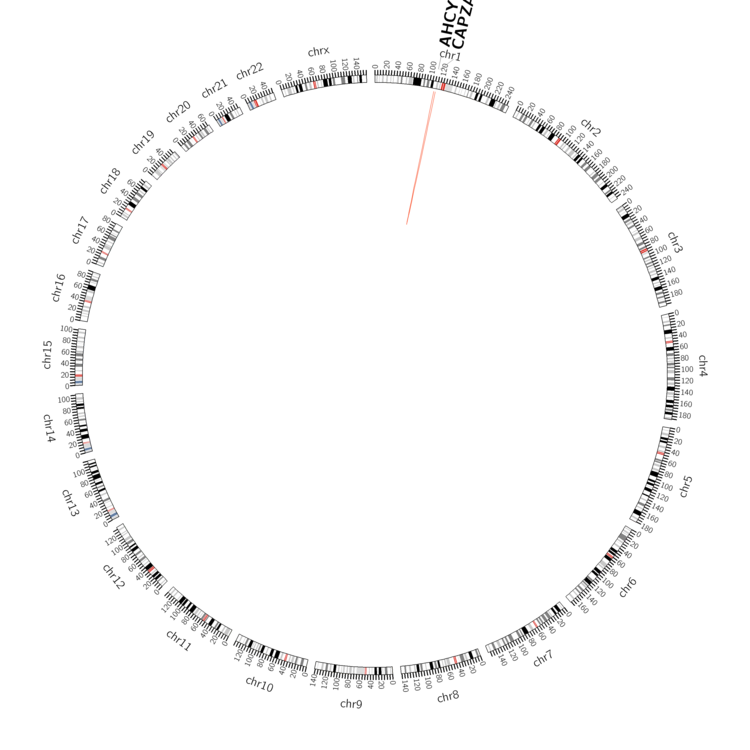 |
| - For Inter-chromosomal Variations |
| There's no inter-chromosomal structural variation. |
| - For Intra-chromosomal Variations |
| * Intra-chromosomal variantions includes 'intrachromosomal amplicon to amplicon', 'intrachromosomal amplicon to non-amplified dna', 'intrachromosomal deletion', 'intrachromosomal fold-back inversion', 'intrachromosomal inversion', 'intrachromosomal tandem duplication', 'Intrachromosomal unknown type', 'intrachromosomal with inverted orientation', 'intrachromosomal with non-inverted orientation'. |
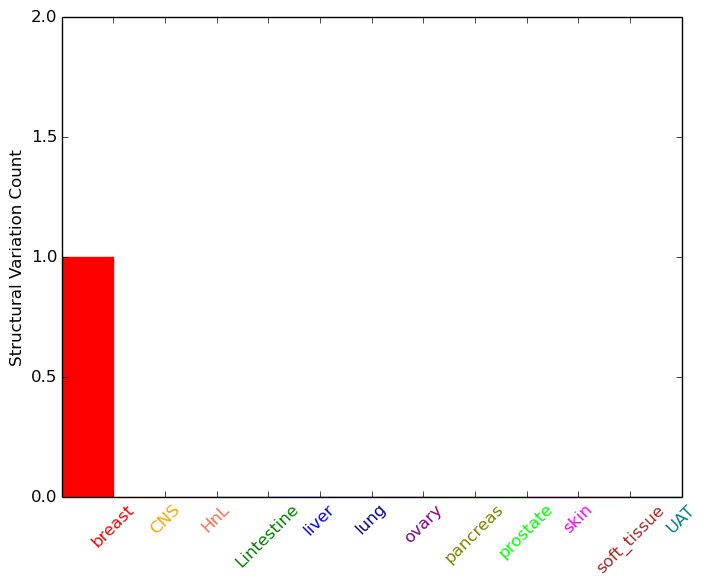 |
| Sample | Symbol_a | Chr_a | Start_a | End_a | Symbol_b | Chr_b | Start_b | End_b |
| breast | AHCYL1 | chr1 | 110543945 | 110543945 | CAPZA1 | chr1 | 113190387 | 113190387 |
| cf) Tissue number; Tissue name (1;Breast, 2;Central_nervous_system, 3;Haematopoietic_and_lymphoid_tissue, 4;Large_intestine, 5;Liver, 6;Lung, 7;Ovary, 8;Pancreas, 9;Prostate, 10;Skin, 11;Soft_tissue, 12;Upper_aerodigestive_tract) |
| * From mRNA Sanger sequences, Chitars2.0 arranged chimeric transcripts. This table shows AHCYL1 related fusion information. |
| ID | Head Gene | Tail Gene | Accession | Gene_a | qStart_a | qEnd_a | Chromosome_a | tStart_a | tEnd_a | Gene_a | qStart_a | qEnd_a | Chromosome_a | tStart_a | tEnd_a |
| CA841960 | MDC1 | 1 | 88 | 6 | 2005120 | 2005207 | AHCYL1 | 82 | 595 | 1 | 110563832 | 110564345 | |
| DA647181 | AHCYL1 | 1 | 544 | 1 | 110564420 | 110564963 | LRRC58 | 545 | 782 | 3 | 120047152 | 120047390 | |
| AA207072 | AHCYL1 | 1 | 24 | 1 | 110535028 | 110535051 | RNFT2 | 21 | 141 | 12 | 117217168 | 117217288 | |
| BQ774807 | AHCYL1 | 18 | 123 | 1 | 110566259 | 110566364 | AHCYL1 | 120 | 765 | 1 | 110564873 | 110565518 | |
| AI800578 | AHCYL1 | 1 | 148 | 1 | 110564858 | 110565005 | AHCYL1 | 143 | 598 | 1 | 110565532 | 110565987 | |
| AI862468 | AHCYL1 | 1 | 246 | 1 | 110564750 | 110564995 | CDK6 | 237 | 476 | 7 | 92366341 | 92366578 | |
| BQ776309 | AHCYL1 | 1 | 43 | 1 | 110565797 | 110566217 | AHCYL1 | 28 | 692 | 1 | 110565596 | 110566197 | |
| AA830163 | RBFOX2 | 14 | 115 | 22 | 36234279 | 36234400 | AHCYL1 | 105 | 434 | 1 | 110561072 | 110563417 | |
| DA382933 | PDXDC1 | 1 | 423 | 16 | 15130378 | 15130799 | AHCYL1 | 415 | 632 | 1 | 110561585 | 110562230 | |
| Top |
| Mutation type/ Tissue ID | brca | cns | cerv | endome | haematopo | kidn | Lintest | liver | lung | ns | ovary | pancre | prost | skin | stoma | thyro | urina | |||
| Total # sample | 1 | 1 | ||||||||||||||||||
| GAIN (# sample) | 1 | |||||||||||||||||||
| LOSS (# sample) | 1 |
| cf) Tissue ID; Tissue type (1; Breast, 2; Central_nervous_system, 3; Cervix, 4; Endometrium, 5; Haematopoietic_and_lymphoid_tissue, 6; Kidney, 7; Large_intestine, 8; Liver, 9; Lung, 10; NS, 11; Ovary, 12; Pancreas, 13; Prostate, 14; Skin, 15; Stomach, 16; Thyroid, 17; Urinary_tract) |
| Top |
|
 |
| Top |
| Stat. for Non-Synonymous SNVs (# total SNVs=38) | (# total SNVs=13) |
 | 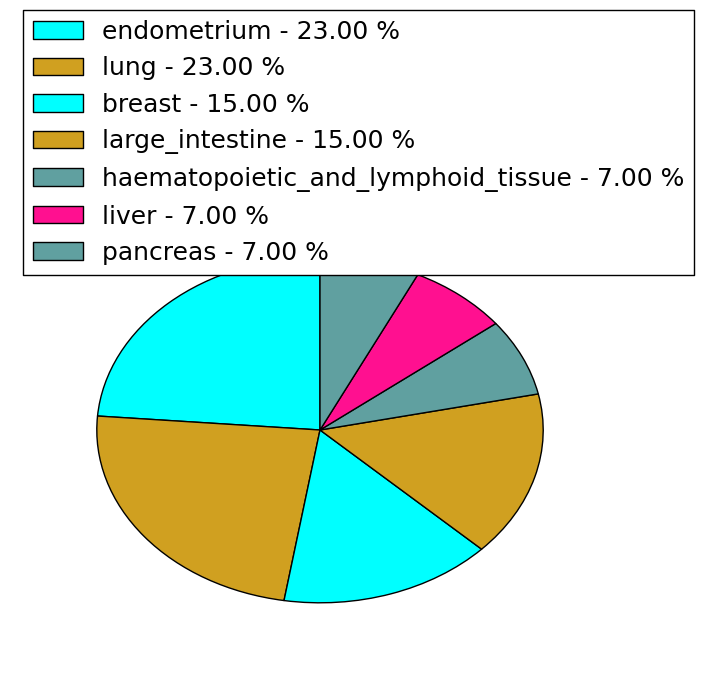 |
(# total SNVs=2) | (# total SNVs=0) |
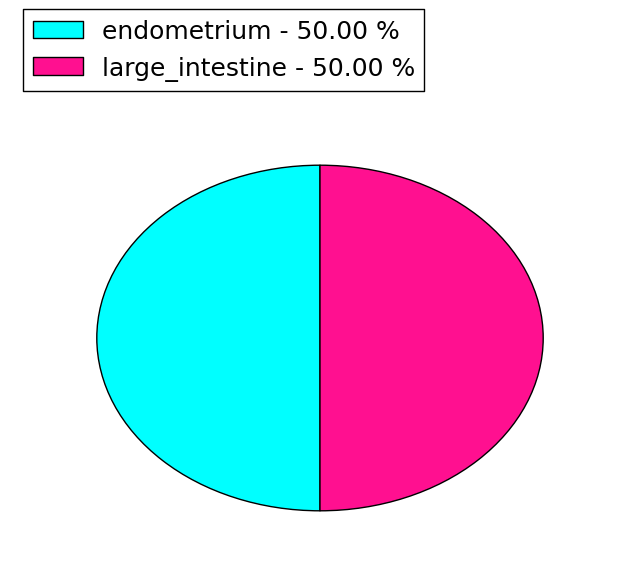 |
| Top |
| * When you move the cursor on each content, you can see more deailed mutation information on the Tooltip. Those are primary_site,primary_histology,mutation(aa),pubmedID. |
| GRCh37 position | Mutation(aa) | Unique sampleID count |
| chr1:110560608-110560608 | p.R365W | 3 |
| chr1:110558115-110558115 | p.I248I | 2 |
| chr1:110560120-110560120 | p.G323S | 2 |
| chr1:110561083-110561083 | p.I404I | 2 |
| chr1:110561085-110561085 | p.D405A | 2 |
| chr1:110560622-110560622 | p.V369V | 2 |
| chr1:110559066-110559066 | p.E295* | 2 |
| chr1:110553838-110553838 | p.A79T | 2 |
| chr1:110563436-110563436 | p.L517F | 2 |
| chr1:110527733-110527735 | p.E21delE | 1 |
| Top |
|
 |
| Point Mutation/ Tissue ID | 1 | 2 | 3 | 4 | 5 | 6 | 7 | 8 | 9 | 10 | 11 | 12 | 13 | 14 | 15 | 16 | 17 | 18 | 19 | 20 |
| # sample | 1 | 1 | 1 | 9 | 1 | 3 | 1 | 6 | 2 | 3 | 1 | 8 | 6 | |||||||
| # mutation | 1 | 1 | 1 | 8 | 1 | 3 | 1 | 6 | 2 | 3 | 1 | 8 | 7 | |||||||
| nonsynonymous SNV | 1 | 1 | 7 | 1 | 3 | 5 | 1 | 3 | 6 | 4 | ||||||||||
| synonymous SNV | 1 | 1 | 1 | 1 | 1 | 1 | 2 | 3 |
| cf) Tissue ID; Tissue type (1; BLCA[Bladder Urothelial Carcinoma], 2; BRCA[Breast invasive carcinoma], 3; CESC[Cervical squamous cell carcinoma and endocervical adenocarcinoma], 4; COAD[Colon adenocarcinoma], 5; GBM[Glioblastoma multiforme], 6; Glioma Low Grade, 7; HNSC[Head and Neck squamous cell carcinoma], 8; KICH[Kidney Chromophobe], 9; KIRC[Kidney renal clear cell carcinoma], 10; KIRP[Kidney renal papillary cell carcinoma], 11; LAML[Acute Myeloid Leukemia], 12; LUAD[Lung adenocarcinoma], 13; LUSC[Lung squamous cell carcinoma], 14; OV[Ovarian serous cystadenocarcinoma ], 15; PAAD[Pancreatic adenocarcinoma], 16; PRAD[Prostate adenocarcinoma], 17; SKCM[Skin Cutaneous Melanoma], 18:STAD[Stomach adenocarcinoma], 19:THCA[Thyroid carcinoma], 20:UCEC[Uterine Corpus Endometrial Carcinoma]) |
| Top |
| * We represented just top 10 SNVs. When you move the cursor on each content, you can see more deailed mutation information on the Tooltip. Those are primary_site, primary_histology, mutation(aa), pubmedID. |
| Genomic Position | Mutation(aa) | Unique sampleID count |
| chr1:110561083 | p.R167H,AHCYL1 | 2 |
| chr1:110557445 | p.I357I,AHCYL1 | 2 |
| chr1:110553923 | p.E93E,AHCYL1 | 1 |
| chr1:110562203 | p.R340H,AHCYL1 | 1 |
| chr1:110558120 | p.A455V,AHCYL1 | 1 |
| chr1:110561051 | p.R126C,AHCYL1 | 1 |
| chr1:110553967 | p.C345Y,AHCYL1 | 1 |
| chr1:110562247 | p.H456N,AHCYL1 | 1 |
| chr1:110558988 | p.Y133H,AHCYL1 | 1 |
| chr1:110561069 | p.I346L,AHCYL1 | 1 |
| * Copy number data were extracted from TCGA using R package TCGA-Assembler. The URLs of all public data files on TCGA DCC data server were gathered on Jan-05-2015. Function ProcessCNAData in TCGA-Assembler package was used to obtain gene-level copy number value which is calculated as the average copy number of the genomic region of a gene. |
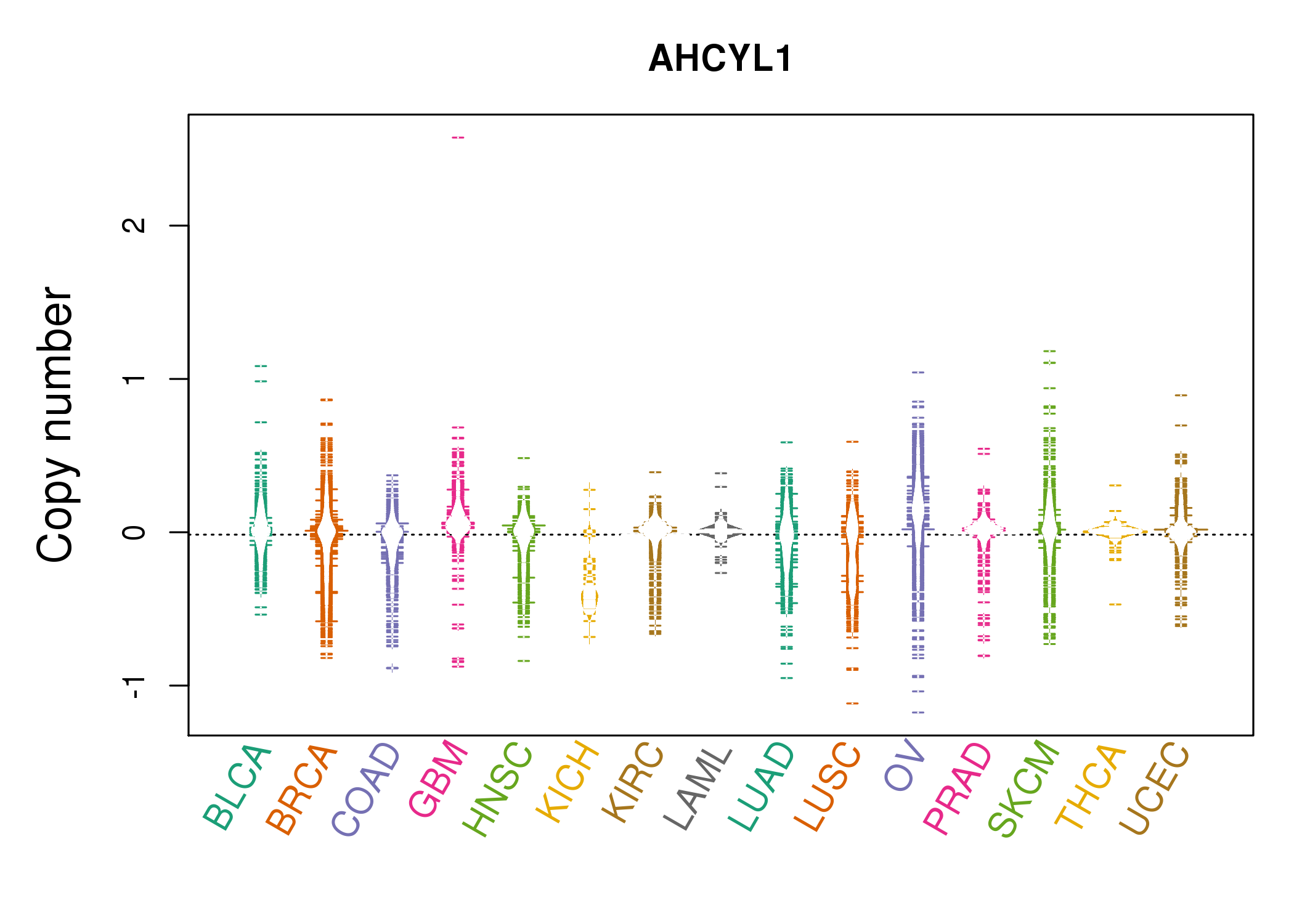 |
| cf) Tissue ID[Tissue type]: BLCA[Bladder Urothelial Carcinoma], BRCA[Breast invasive carcinoma], CESC[Cervical squamous cell carcinoma and endocervical adenocarcinoma], COAD[Colon adenocarcinoma], GBM[Glioblastoma multiforme], Glioma Low Grade, HNSC[Head and Neck squamous cell carcinoma], KICH[Kidney Chromophobe], KIRC[Kidney renal clear cell carcinoma], KIRP[Kidney renal papillary cell carcinoma], LAML[Acute Myeloid Leukemia], LUAD[Lung adenocarcinoma], LUSC[Lung squamous cell carcinoma], OV[Ovarian serous cystadenocarcinoma ], PAAD[Pancreatic adenocarcinoma], PRAD[Prostate adenocarcinoma], SKCM[Skin Cutaneous Melanoma], STAD[Stomach adenocarcinoma], THCA[Thyroid carcinoma], UCEC[Uterine Corpus Endometrial Carcinoma] |
| Top |
| Gene Expression for AHCYL1 |
| * CCLE gene expression data were extracted from CCLE_Expression_Entrez_2012-10-18.res: Gene-centric RMA-normalized mRNA expression data. |
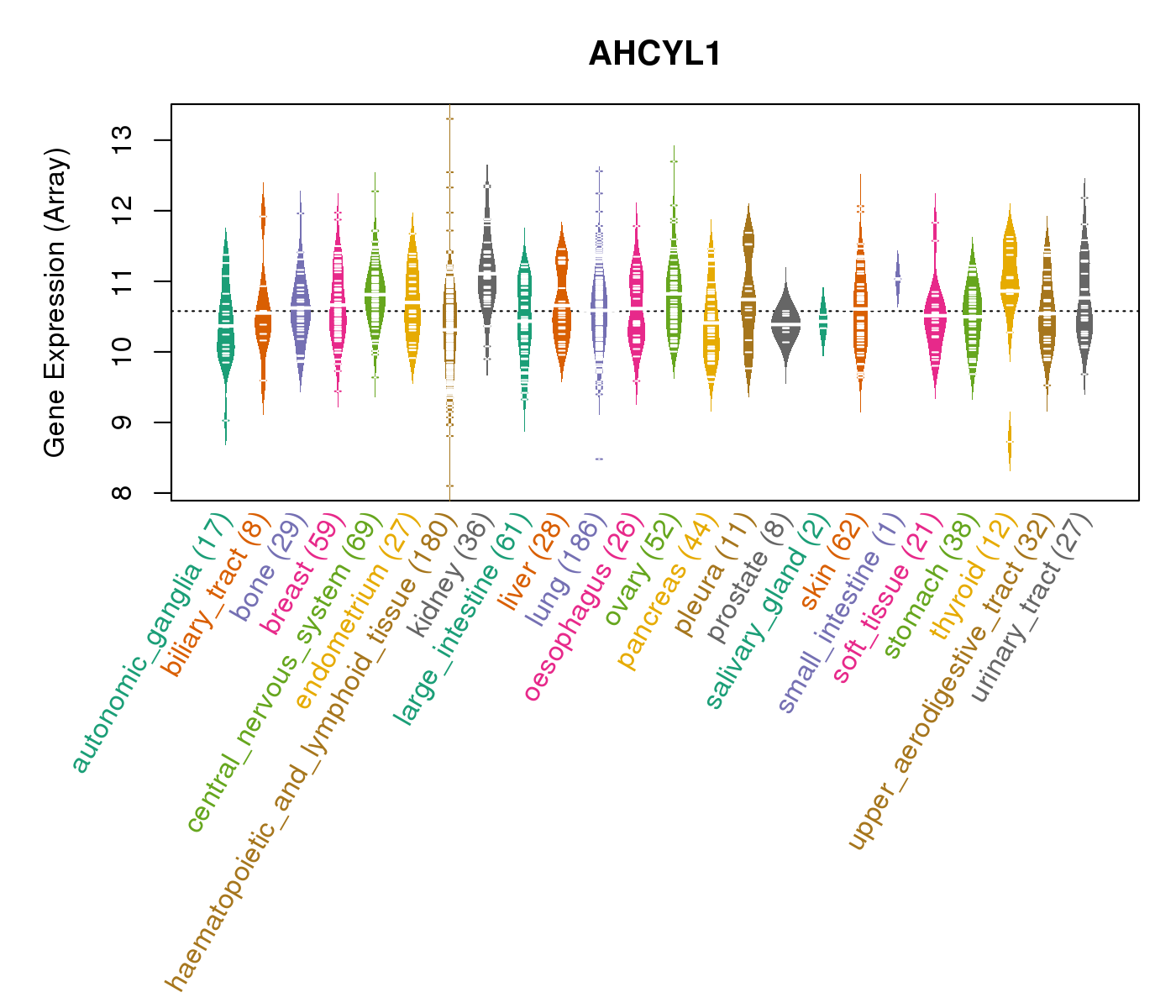 |
| * Normalized gene expression data of RNASeqV2 was extracted from TCGA using R package TCGA-Assembler. The URLs of all public data files on TCGA DCC data server were gathered at Jan-05-2015. Only eight cancer types have enough normal control samples for differential expression analysis. (t test, adjusted p<0.05 (using Benjamini-Hochberg FDR)) |
 |
| Top |
| * This plots show the correlation between CNV and gene expression. |
: Open all plots for all cancer types
 |
|
 |
|
| Top |
| Gene-Gene Network Information |
| * Co-Expression network figures were drawn using R package igraph. Only the top 20 genes with the highest correlations were shown. Red circle: input gene, orange circle: cell metabolism gene, sky circle: other gene |
: Open all plots for all cancer types
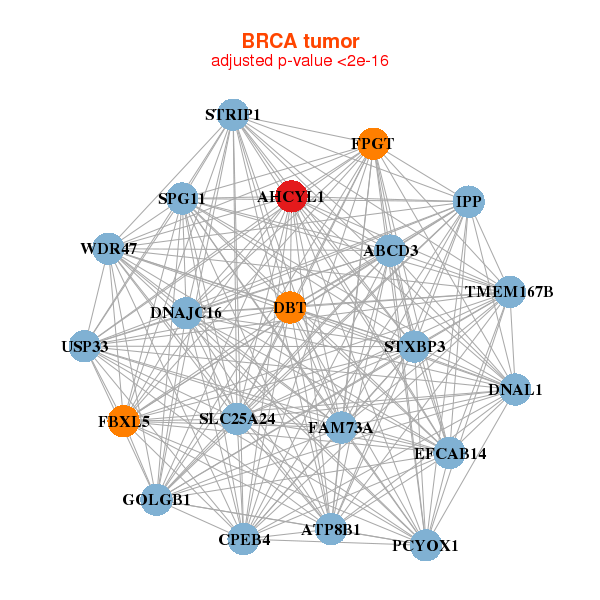 |
|
| ABCD3,AHCYL1,ATP8B1,CPEB4,DBT,DNAJC16,DNAL1, STRIP1,FAM73A,FBXL5,FPGT,GOLGB1,IPP,EFCAB14, PCYOX1,SLC25A24,SPG11,STXBP3,TMEM167B,USP33,WDR47 | AHCYL1,ASPH,ATP9A,CCPG1,COBLL1,DDHD2,DYNC1LI2, IMPAD1,ITGB1,JAK1,KCTD20,KLHL5,PARVA,PCYOX1, PTPN11,RABL3,RNF14,SEC22B,SEPT11,SNX19,STS |
 |
|
| ABCD3,AGL,AHCYL1,ALG6,CEPT1,CLCC1,CSDE1, DBT,DDAH1,FAM102B,GNAI3,HIPK1,MAGI3,PKN2, RSBN1,SCP2,SERBP1,SLC25A24,SLC35A3,STXBP3,TAF13 | AHCYL1,ALS2,AQP1,BCO2,CDR2L,CREB3L2,CYP2U1, DEFB131,ESRRG,HOXC11,HOXC5,KCTD3,KIFC3,MAOB, NBAS,PHYHIPL,PMP22,SFXN3,SUSD2,TIAM2,TMEM25 |
| * Co-Expression network figures were drawn using R package igraph. Only the top 20 genes with the highest correlations were shown. Red circle: input gene, orange circle: cell metabolism gene, sky circle: other gene |
: Open all plots for all cancer types
| Top |
: Open all interacting genes' information including KEGG pathway for all interacting genes from DAVID
| Top |
| Pharmacological Information for AHCYL1 |
| There's no related Drug. |
| Top |
| Cross referenced IDs for AHCYL1 |
| * We obtained these cross-references from Uniprot database. It covers 150 different DBs, 18 categories. http://www.uniprot.org/help/cross_references_section |
: Open all cross reference information
|
Copyright © 2016-Present - The Univsersity of Texas Health Science Center at Houston @ |






